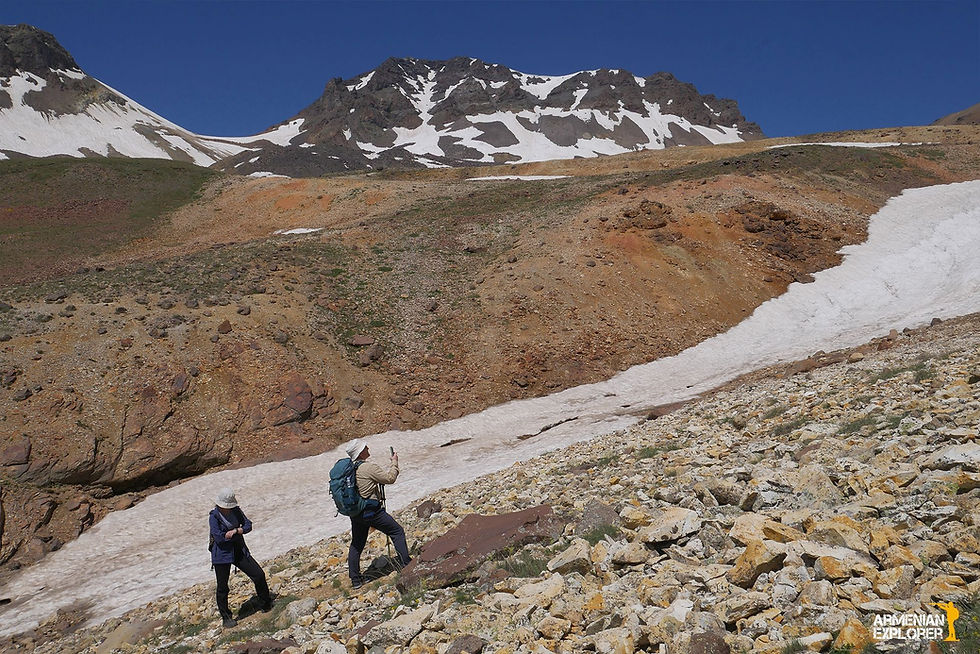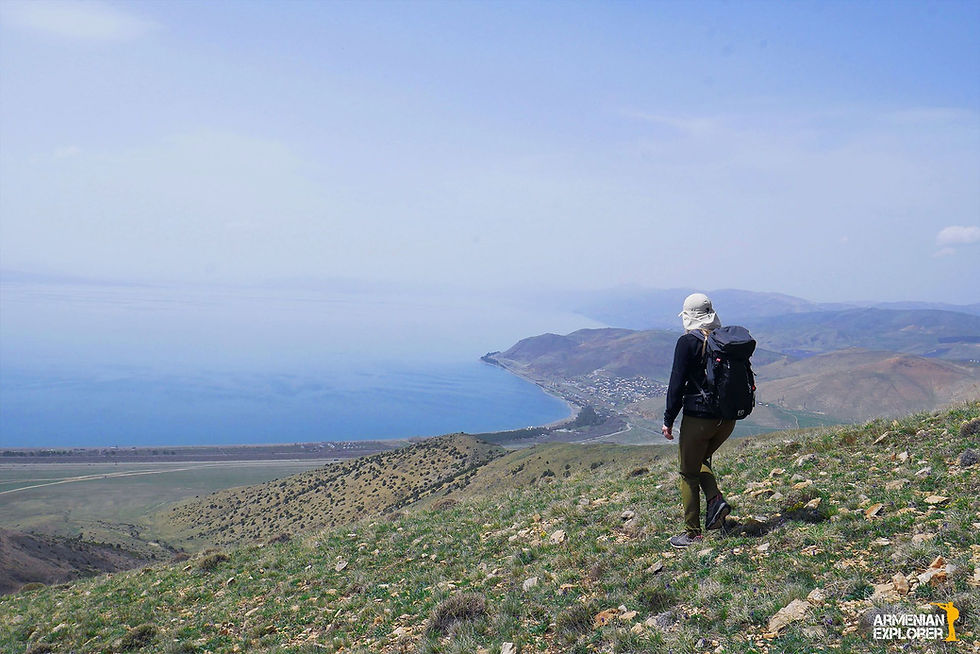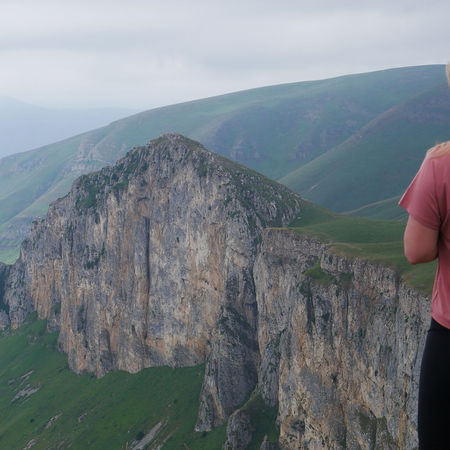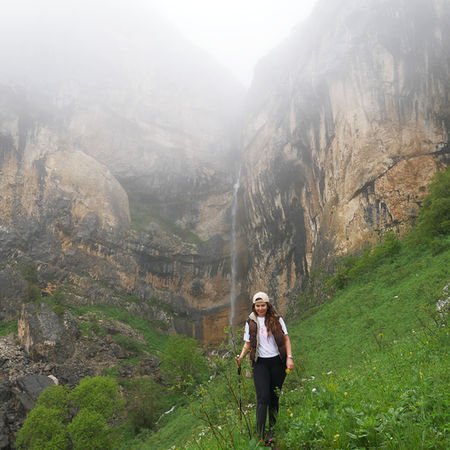

Guide in Armenia
I’m Suren, your tour guide in Armenia. In this article, I’ll tell you a bit about myself and the services I offer, while sharing practical advice for travelers planning a trip to Armenia. My expertise lies in urbex, hiking, off-roading, and sightseeing tours — so that’s where we’ll focus. The tips I share come from both my own experience and valuable feedback from travelers I’ve guided through these places. Trust me — I know the way.
About me...
I’m Suren, a professional tour guide in Armenia. Many travelers look for guides who also provide transportation — yes, I drive my own car. My goal is to make your trip efficient, memorable, and budget-friendly. (Photo and more details below.) Since 2014, I’ve been guiding travelers across the country — from easy hiking trails to challenging mountain summits, remote off-road routes, and explorations of abandoned places. Over the years, I’ve gained both deep knowledge and practical experience, which I’m happy to share with anyone planning to hike in Armenia. During my tours, I bring along a photo album featuring historical images. It lets visitors see how landmarks looked before restoration—or even before they disappeared entirely.
So, lace up your boots — let’s get started!

Yep, that’s me posing for a photo in the sacred valley of Tirinkatar, near the Armenian vishap — the ancient “dragon stone”!
During my freelance work with various tour agencies, I noticed that many travelers struggle to get in direct contact with local guides. When I launched my website, my goal was to make it easier for travelers to connect directly with a guide — to discuss upcoming trips, customize itineraries, and decide whether the guide is the right fit for their holiday experience. After all, it’s the guide — not the tour agency — who shares both the challenges and the joys of the journey with travelers.

My car, a Mitsubishi Pajero 4, is my reliable workhorse — built to handle tough terrain and ensure every tour runs smoothly and to its fullest potential.
And that’s where Armenian Explorer comes in — to make that connection possible. I hope this article helps more travelers find me and boosts my visibility in search results. Having a master’s degree in Comparative Literature helps me access and interpret a wide range of historical information about Armenia, allowing me to share it with travelers and tell the stories behind each unique place we visit. The tours are conducted in English or Russian, and I also have a basic knowledge of German.

On the shore of Lake Kari (3,200 m), after taking a memorable photo with a group from Singapore, I’ll be guiding them to the summit of the southern peak of Mount Aragats.
Now I’ll provide concise, step-by-step information about the most popular tourist destinations in Armenia. Let’s start with hiking.
Armenia is a paradise for hikers. The country offers trails of all difficulty levels — from gentle forest walks to challenging climbs above 3,000 meters.
In winter, we usually avoid peaks higher than 3000 meters because of deep snow and mud, which make both hiking and off-road access impossible.
From June to late October, conditions improve; at lower altitudes it can be quite hot, making this the best season for climbing Armenia’s 3,000-plus-meter summits.
Mount Azhdahak
One of the most popular hiking destinations in Armenia is Mount Azhdahak (3,597 m) — the highest point of the Geghama mountain range. The “Red Giant” is famous for its volcanic lake at 3,500 meters and the panoramic views of Lake Sevan, Lake Akna, and surrounding peaks like Red Ridge and Spitakasar.
Yes, you can also swim in the crater lake, so bring your swimwear. Keep in mind, however, that the water is very cold — around 10°C even in the hottest summer days — and the lakebed is covered with sharp rocks. Swimming in deeper areas is strongly not recommended.

The most common trail starts near Mount Paytasar, but for beginner hikers, I often drive up closer to Azhdahak’s base — leaving only about a 50-minute hike to the summit. Lake Akna, Lake Badi, and Dragon Lake are among the most popular camping spots in this area, but we will talk about it later.
The Geghama Mountains are ideal not only for day hikes but also for multi-day trekking and camping adventures, which I regularly include in my tours.

A quick stop near the Geghama petroglyphs to explore these ancient carvings.
Important! Over the years, I’ve encountered many tourists who tried to reach Mount Azhdahak with a rental crossover, only to turn back when they found the terrain too rocky and dangerous for such vehicles. You’ll need a strong, high-clearance car, solid driving and navigation skills, and the ability to handle unexpected challenges. Mud is usually not an issue — you won’t get stuck — but slippery slopes are common, and rainy days can make the route especially difficult.
Starting the hike from Geghard village can be quite difficult, especially if you don’t know the locations of the water springs. If you’re not an experienced hiker with good map and navigation skills, it’s better to hire a guide.
In the Geghama Mountains, you will find yourself in absolute wilderness, so don’t expect to find a toilet.
Mount Aragats — The Roof of Armenia
Another must-visit hiking destination is Mount Aragats (4,090 m) — the highest mountain in Armenia. It has four distinct peaks:
Northern Summit — 4,090 m (the highest point in Armenia)
Western Summit — 3,995 m
Eastern Summit — 3,908 m
Southern Summit — 3,888 m

There are two main starting points for climbing Aragats — Lake Kari (3,200 m) and Gegharot Waterfall (3,000 m).
Lake Kari is easily accessible by car thanks to an old asphalt road built during Soviet times, more than half a century ago, to allow scientists to reach the Cosmic Ray Research Station. It also serves as a convenient base for climbing all four peaks of Mount Aragats. However, the road is open only from mid-May to the end of October. On the shore of Lake Kari, there is a restaurant and a hotel, but don’t expect to use their toilets. You will need to rely on an open-air toilet—beware of this.

In late October 2025, we got stuck in deep snow, as this area is highly exposed to strong winds and snowstorms that often block the road. Luckily, while we were enjoying a cup of coffee, a bulldozer arrived and cleared the road.
Gegharot Waterfall offers a shorter route to the northern and eastern summits but requires a high-clearance off-road vehicle to reach. Keep in mind that the road to Gegharot is just as rough as the one to Mount Azhdahak — a sturdy vehicle is a must. Last time I was there, I saw dozens of cars abandoned along the way; their drivers realized too late that the rocky terrain would destroy their plastic crossovers, so they gave up on climbing Aragats and were lucky just to make it as far as the waterfall.
In this area, you are already far from any civilization—only tourists and shepherds may be encountered here. There are no toilets and no tourist infrastructure. Wild Armenia welcomes you!

We have just reached the crater of mount Aragats and are ready for the final summit push!
If you’re fit and up for a challenge, you can conquer two peaks in a single day — usually the Southern and Western summits. For a more immersive experience, consider a two-day trek: start from Lake Kari, climb the first two peaks, camp overnight inside Aragats’ massive crater, and the next day, ascend the Northern and Eastern summits before descending to Gegharot waterfall, where an off-road car can meet you.
Winter and Easy Hikes in Armenia
In winter, I recommend hikes to Lastiver, the Lake Parz–Goshavank trail, Smbataberd (Fortress of Smbat), or a climb to Mount Artanish.
The summit of Mount Artanish is the only point from where you can see the entire Lake Sevan from above — a view that’s truly unforgettable. Located in the Gegharkunik region, on the eastern shore of Lake Sevan, the mountain stands on the Artanish Peninsula, which separates Big and Small Sevan. Rising to 2,460 meters above sea level with a relative height of 560 meters, this hike covers about 5 km one way, takes around 2.5 hours, and involves an elevation gain of 560 meters.

Descending from mount Artanish!
Lastiver is home to a two-story cave carved into a steep canyon slope near the majestic gorge of the Khachaghbyur River. Surrounded by towering trees, rugged cliffs, and the soothing sound of the river, this place feels like stepping into a fairy tale.

In the 1970s, Soviet-Armenian sculptor Benik Petrosyan decorated the cave walls with striking bas-reliefs, enhancing its mysterious aura. Many visitors mistakenly believe these carvings are ancient, which only adds to the sense of wonder.
Historically, the caves of Lastiver served as a refuge for locals during the Mongol invasions of the 13th and 14th centuries. To reach the caves, people built wooden staircases resembling rafts — which is how the site got its name, “Lastiver,” derived from Armenian.
The hike to Lastiver covers about 3.5 km one way, takes roughly 2 hours, and starts about 145 km from Yerevan.

It was a rainy day when we started our hike to Lastiver!
For a scenic two-day trek, the Lori region is one of my favorites. The Lori Canyon provides breathtaking views, and along the way, you can visit several UNESCO World Heritage Sites — a perfect mix of nature and culture.
A hike along Lori Canyon to Horomayr Monastery or to Kayan Fortress is something you’ll love. Unlike the Gegharkunik or Aragatsotn regions, this area is covered with thick forests—if you appreciate that, this region is perfect for you.

The lovely Lori Kanyon
Sightseeing tours in Armenia
The most popular sightseeing tours in Armenia include Echmiadzin Cathedral, Garni Pagan Temple, Geghard Monastery, and Sevanavank. These sites are not only historically and architecturally significant but also conveniently located near Yerevan, making them must-visit destinations. For travelers with more time, Haghpat and Sanahin, both UNESCO World Heritage sites, are essential stops. Other highly recommended destinations include Khor Virap, Noravank, and Tatev Monastery. Here’s a brief overview of these remarkable locations.

Etchmiadzin Cathedral is the mother church of the Armenian Apostolic Church, located in the city known both as Etchmiadzin (Ejmiatsin) and Vagharshapat, Armenia. It is widely recognized as the first cathedral built in ancient Armenia and is often regarded as the oldest Christian cathedral in the world.
Garni Pagan Temple & Geghard Monastery Tour
The Garni-Geghard tour is one of Armenia’s most popular sightseeing experiences, offering a journey from ancient pagan traditions to the dawn of Christianity. Located just a short drive from Yerevan, these landmarks offer an excellent opportunity to explore Armenia’s rich cultural and historical heritage within a few hours. Moreover, thanks to their close proximity, even private tours here are quite budget-friendly.

Garni Pagan Temple, built in the 1st century AD during the reign of King Tiridates I, is the only surviving Greco-Roman colonnaded temple in the post-Soviet region. Dedicated to Mihr, the Armenian sun god, it endured centuries of history, including Armenia’s conversion to Christianity in 301 AD. Destroyed by an earthquake in 1679, it was meticulously restored in the 1970s. Today, Garni stands as a rare testament to Armenia’s pre-Christian heritage. On the territory of Garni Fortress, a free toilet is available.

Geghard Monastery, a UNESCO World Heritage site in Kotayk Province, dates back to the 4th century and was founded by St. Gregory the Illuminator. Its name, meaning “Monastery of the Spear,” comes from the Holy Lance—the relic believed to have pierced Jesus Christ’s side during the crucifixion, brought to Armenia by the Apostle Thaddeus. While the relic is now kept in the Treasury of Etchmiadzin, Geghard remains a stunning example of rock-hewn Armenian architecture and spiritual significance. Near Geghard Monastery, a paid toilet is available for just 100 AMD.
Khor Virap Monastery, set against the majestic backdrop of Mount Ararat, is one of Armenia’s most sacred pilgrimage sites. It marks the 13-year imprisonment of Gregory the Illuminator by King Tiridates III, after which Gregory became the king’s religious mentor, leading Armenia to become the world’s first Christian nation in 301 AD.

The first chapel at Khor Virap was built in 642 by Nerses III the Builder to honor Saint Gregory. Over the centuries, it underwent several reconstructions, and in 1662 the larger St. Astvatsatsin (Holy Mother of God) chapel was built around the original structure, incorporating the monastery, refectory, and monks’ cells.

Noravank, a 13th-century Armenian monastic complex, is famed for its Surb Astvatsatsin (Holy Mother of God) and Surb Karapet (St. John the Baptist) churches. Nestled in a gorge of striking red cliffs, it is one of Armenia’s most photogenic and popular tourist destinations.

Sevanavank is a 9th-century monastic complex located on a peninsula of Lake Sevan in the Gegharkunik Province of Armenia. The complex consists of two churches: Surb Arakelots (“Holy Apostles”) and Surb Astvatsatsin (“Holy Mother of God”), both built with cruciform plans and octagonal tambours.

Sanahin and Haghpat Monasteries, both UNESCO World Heritage Sites, are not only remarkable examples of medieval Armenian architecture but also cinematic landmarks. Scenes from Sergei Parajanov’s iconic film The Color of Pomegranates (1969) were filmed here, adding artistic and cultural depth to these already majestic monastic complexes.
Urbex tours in Armenia
After the collapse of the Soviet Union, many industrial plants, hotels, pioneer camps, culture houses, cable car stations, and other facilities were abandoned, looted, or fell into decay. Over time, these sites have gained a mysterious and captivating atmosphere, attracting travelers fascinated by urbex and abandoned places. Today, they are highly sought-after by urban explorers, and the private guided tours I offer attract hundreds of tourists each year. Here are a few of the remarkable urbex destinations where I personally guide my clients.

Hidden in the serene hills of Orgov lies ROT54, a massive, now-abandoned scientific telescope. Built between 1975 and 1985, it features a 54-meter (177 ft) dish and was once among the world’s most advanced radio-optical telescopes. The project was conceived by Paris Herouni, an Armenian radio astronomer, physicist, and engineer, who spent years persuading Soviet authorities to approve its construction in Armenia.

The control room of ROT54
The telescope operated from 1986 until 1990. In the mid-1990s, restoration efforts began: between 1995 and 2010, it was partially modernized with new control systems and equipment, allowing observations to resume with support from the Astronomical Society of Russia and the National Technical University of Athens. However, in 2012, a control arm failed, disabling the secondary mirror and halting operations once again. With no funds available for repairs, the facility was ultimately mothballed.

Carlus from Spain is happy to finally visit this place
From my personal experience, I can tell you that this is one of the most popular destinations for urban explorers, and I often receive requests to take tourists here. A typical tour to ROT54, if we start early at around 7:50 AM from Yerevan, takes about four hours in total — we’re back in the city by midday. So even if you’re using Armenia as a transit stop or are short on time, this is a destination you shouldn’t miss before leaving.
The Trophy 1-Meter Schmidt Telescope — Hitler’s Gift to Mussolini
On the way to ROT54, we pass through the village of Byurakan, where in 1946 Viktor Hambardzumyan founded one of Armenia’s most renowned scientific centers — the Byurakan Observatory. Several telescopes here are open for visitors, but the one that draws the most attention is the legendary 1-meter Schmidt telescope.

This telescope carries significant historical value — it was originally a gift from Hitler to Mussolini, and its inauguration was attended by Soviet leader Nikita Khrushchev. Beyond its political past, it played a key role in major astronomical discoveries.

The building that houses the ZTA-2.6 telescope...
In 1965, Benjamin Markarian used the Schmidt telescope to conduct the First Byurakan Survey (FBS). Through these observations, he discovered numerous faint galaxies, from the 13th to 17th magnitude, notable for their excess ultraviolet radiation. These celestial bodies became known as Markarian galaxies in his honor.
Armenia’s Particle Accelerator
Just a short drive from central Yerevan, in what were once the city’s outskirts during the 1960s, stands something few would expect from a small mountainous country better known for its ancient monasteries and volcanic peaks — a particle accelerator.

Founded in 1943 as a branch of Yerevan State University by renowned physicists Abraham Alikhanov and Artem Alikhanyan, the Yerevan Physics Institute (YerPhI) soon became a cornerstone of Armenia’s scientific ambitions.
In 1965, the LU-75 linear accelerator was completed, and two years later it was joined by a 6 GeV synchrotron. Though its raw power could not match modern giants like CERN, this facility was once among the most advanced in the Soviet Union, operating for over 5,000 hours annually at its peak.

The “Arus” synchrotron — about 70 meters in diameter and 220 meters in circumference — was designed to accelerate electrons to 6 GeV. It also generated a beam of linearly polarized photons in the 0.9–1.8 GeV range, enabling high-precision experiments in particle physics and interactions.
Tours to an Abandoned Refractory Brick Factory
During my urbex tours, we also explore a massive Soviet-era refractory brick factory — a haunting reminder of Armenia’s industrial past.

Built in 1951, the factory was strategically positioned near a rich clay deposit, crucial for producing high-quality fire-resistant bricks. At its peak, it employed over 600 workers, forming the backbone of the local economy and sustaining nearby villages and towns. Every day, seven to eight railway wagons carried bricks to Russia, fueling the Soviet Union’s vast industrial demand.

Stepping inside today feels like entering a time capsule. Rusting machinery, heavy-duty tools, and even Soviet trucks remain scattered across the vast production halls. Strange metal devices — their purpose now forgotten — lie untouched, frozen in time as industrial relics of a vanished era.
The Iron Fountain in Gyumri
Despite being abandoned and surrounded by scattered debris, this rusty iron fountain in Gyumri continues to draw curious visitors from around the world — and it’s always on my must-see list when touring the city.

This post-apocalyptic masterpiece, officially named the “Friendship” Fountain but better known as “The Iron Fountain,” was designed by renowned Armenian architect Arthur Tarkhanyan. Inaugurated in 1982, it quickly became a favorite gathering place for locals, especially during evening walks.
Although the fountain itself survived the devastating 1988 earthquake, the surrounding area fell into neglect. The difficult post-earthquake years left little room for restoration, and the site has since remained a striking symbol of Gyumri’s resilience and faded Soviet grandeur.
Tour to an Abandoned Carpet Factory
Among my urban exploration tours, one of the most striking stops is this abandoned carpet factory — a vast, silent monument to Armenia’s industrial heritage.

Once buzzing with thousands of workers, this colossal plant could produce up to one million square meters of carpet annually. Founded in 1964, it specialized in crafting various types of carpets — including double-walled, jacquard, and five-color designs — using materials such as New Zealand wool, domestic capron, and copper-ammonia fiber.

At its peak in 1975, the factory reached record production levels, earning international recognition for the beauty and craftsmanship of its carpets, which combined traditional Armenian patterns with modern aesthetics.

These works were exhibited across the globe — from Montreal and São Paulo to Beirut, Baghdad, Prague, Plovdiv, Leipzig, and even at the Exhibition of Achievements of the People’s Economy of the USSR (VDNKh).
Tours to Soviet-era sanatoriums
During my urbex tours, we also explore Soviet-era sanatoriums — both still operating and long abandoned. Many of these places hold fascinating stories, as some were built by German war captives after World War II.

Their architecture alone is worth the visit: grand, atmospheric, and often surprisingly elegant, these buildings never fail to captivate those who step inside.

Although this one is abandoned, it remains well-preserved and features wide corridors, elegant balconies, and a mysterious atmosphere that continues to attract visitors from around the world.
Tours to Soviet-Era Pioneer Camps
This abandoned pioneer camp in Armenia is one of the best-preserved I’ve ever seen. As you explore its overgrown grounds, you’ll encounter striking relics of the past — from grand mosaics adorning the swimming pool walls to statues of iconic figures like Buratino and Medz Mher.

During the Soviet era, Armenia had around 200 pioneer camps, but only about ten survived after the collapse of the USSR. These camps were typically located outside cities, nestled in the woods, offering children a retreat into nature.

The “Fairy-Tale” camp was among the finest in Armenia. It officially opened in 1985 and operated until roughly 1993. Its story was dramatically affected by the 1988 earthquake, which partially destroyed buildings and delayed renovations. By the time the camp reopened, the Soviet Union had dissolved, marking the end of its era.

Hidden in Yerevan’s Hrazdan Gorge lies the abandoned Children’s Railway, a nostalgic remnant of Soviet-era Armenia. Built in 1937, it once delighted generations with its charming trains and stations named Motherland, Pioneer, and Happiness. The railway’s elegant station, designed by prominent Armenian architects, still stands surrounded by nature, its stained-glass windows perfect for photography. Though now privatized and silent, traces of its past glory remain everywhere. If you enjoy forgotten places with history and atmosphere, this spot is well worth a visit.
Լուսանկարներ
































